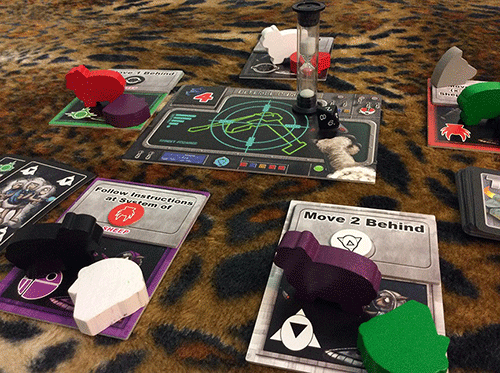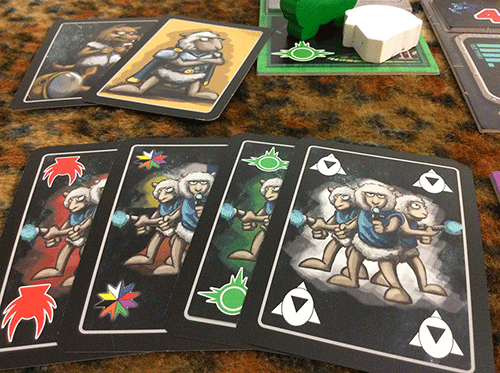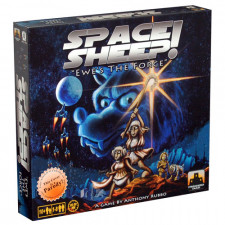Space Sheep! Review
on Jun 8, 2016

Are you a fan of logic puzzles? Think the Tower of Hanoi, the Two Teapots, and the Seven Bridges of Königsberg. If so, you've probably heard the one where a shepherd needs to transport a sheep, a wolf, and a head of cabbage across a river in a ferry that can only carry two creatures at a time. Space Sheep! is what you'd get if, instead of a leaky ferry, the shepherd had an Infinite Improbability Drive. Or it's a bit like solving a Rubik's tesseract. Now mix in a Star Wars meets Aesop's Fables visual style (the bright orange "This cover is a PARODY!" sticker feels a lot less gratuitous now that Boss Disney owns the Star Wars IP) and a challenging real-time element. Puzzle-game nirvana for some. For others, it's as fun as counting sheep.
In the distant Lambda Sector, centuries of peace have been shattered by the arrival of Wolf, a destructive invasion force bent on total sheep destruction. Member of Strategic Sheep Command, under the guidance of the Supreme Flock Commander, must mobilize the Shepherd-class ships and the Spatial Sheep Distortion Drives to return all sheep and Shepherds to their home systems before the Wolf menace can strike in full force.
In gameplay terms, Space Sheep! is all about getting the Sheep and Shepherds--heavy, brightly colored wooden sheeples--to the matching-colored system. Movement is accomplished by playing colored Tactics cards to activate a system's movement protocols. Each movement displaces the matching piece in the destination system, effectively swapping them so that each system will always contain exactly 1 Sheep and 1 Shepherd.
Shepherds are special: if a Shepherd is united with its same-colored Sheep, they can move as a pair when using the systems' instruction tiles. Alternately, a Shepherd can move (by itself) one system clockwise, regardless of its system's instructions.

The real challenge and "fun" of the game comes from the interactions between the instruction tiles and the other game elements. You can choose, or pick randomly, from over 20 tiles covering a universe of complexities. The simplest just say to move forward (clockwise) or back (counterclockwise). Those of medium complexity refer to the constantly changing board state: "Move 1 Past [ ] Sheep"; "Move 2 Behind [ ] Shepherd." (The blanks are filled with a random colored chit just before the game begins.) The most complicated reference multiple variables simultaneously: "Move 1 Past [ ] Shepherd if that color Sheep is Home. Otherwise, Move 1 Behind that color Shepherd." "Move X Forward (x = number of Shepherds at Home)." Even the simplest setups require keen spatial awareness and forward planning: remember that each time you move a piece, you are actually moving another piece in the opposite direction, and you're making all these calculations under pressure of the encroaching Wolf threat.
When the Wolf Fleet is present and active in a system, you can discard a card matching the system's color to disable the enemy's forces, knocking the Wolf meeple on its side. A constantly running sand timer represents the time until the Wolf Fleet's next attack. If it's ever allowed to run out, 4 cards are discarded from the top of the Tactics deck, cutting into your already limited resources. At any time, the Supreme Flock Commander can stand up the Wolf, move it to a random new system, and flip the timer, buying the Flock some time. Because you're reversing a sand timer instead of resetting a clock, you want to cut it as close as possible, but splitting your attention between puzzle-solving and timer-gazing is more taxing than you'd expect.
Masochists or number gurus may enjoy the Allegiance cards, which introduce the possibility that one or more players are "Wolves in Sheep Commander's Clothing," secretly working to undermine the efforts of the Flock. If your game group isn't made up of math Ph.D's or MENSA elite, you'll probably never touch this option—the puzzle on the board will give you more than enough to think about already.
Even without the hidden traitor, Space Sheep! offers a number of dials players can twist to customize the challenge. You can increase or decrease the number of cards discarded when the Wolf strikes, try out different complexities of instruction tiles, increase or decrease the number of Tactics cards and/or wilds, or add or remove systems, with each color added increasing the complexity exponentially. Even the same systems, cards and instruction tiles will yield a new puzzle each time, since the color chits drawn, the distribution of instructions, the starting placement of Sheep and Shepherds, and the order Tactics become available will all be randomized for each play.
The sand timer provided can be difficult to manage while you're focused on a complex problem, but Stronghold's timer app takes care of that limitation while also allowing you to fiddle with the last remaining variable, the length of the countdown. The randomized setup can result, rarely, in an impossible loop or a 3-move solve, but beating the Wolf is always satisfying—if you like logic puzzles.

 Customer Support
Customer Support  Subscribe
Subscribe 




 Account
Account  Wishlist
Wishlist 

